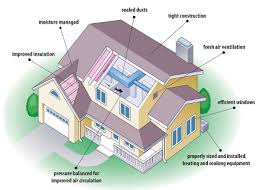
Energy-Efficient Home Improvement Ideas
In today’s world, energy efficiency is no longer just a buzzword, but an important aspect of daily life. Energy-efficient homes not only help reduce energy costs, but also contribute to a healthier environment by reducing carbon emissions. In this article, we will discuss some energy-efficient home improvement ideas that can help you save energy and money.
Use LED light bulbs
One of the simplest ways to make your home more energy-efficient is to switch to LED light bulbs. LED bulbs use up to 75% less energy than traditional incandescent bulbs and can last up to 25 times longer. While they may be more expensive upfront, they will save you money in the long run on your electricity bill and reduce the need for frequent bulb replacements.
Upgrade to energy-efficient appliances
Older appliances can be energy hogs, so upgrading to energy-efficient appliances is a smart investment in the long run. Look for appliances with the ENERGY STAR® label, which indicates they meet strict energy efficiency guidelines set by the U.S. Environmental Protection Agency (EPA). These appliances can help reduce your energy bills while also reducing your carbon footprint.
Seal air leaks
Air leaks can cause significant energy loss, so sealing them up is an easy way to improve energy efficiency. Common areas for air leaks include windows, doors, and electrical outlets. Seal any gaps with weatherstripping or caulking to prevent drafts and improve energy efficiency.
Install a programmable thermostat
A programmable thermostat can help you save energy and money by automatically adjusting the temperature in your home based on your schedule. By lowering the temperature at night or when you’re away from home, you can reduce energy consumption and save money on your energy bills.
Upgrade insulation
Upgrading insulation is another effective way to improve energy efficiency. Adding insulation to your walls, attic, and floors can help keep your home warm in the winter and cool in the summer, reducing the need for heating and cooling systems. This can result in significant energy savings over time.
Use low-flow showerheads and faucets
Using low-flow showerheads and faucets can help reduce water usage, which in turn reduces the energy needed to heat the water. By conserving water, you’re also helping to preserve this precious resource and reducing your environmental impact.
Install solar panels
If you’re looking for a larger-scale energy-efficient home improvement, consider installing solar panels. Solar panels can help reduce your reliance on grid energy and provide a clean and renewable source of power. While the initial cost can be high, the savings in energy costs over time can make it a smart investment. And if you need extra funding look up solar panel funding if it’s available in your country since governments will help you transition to green energy.
Use smart home technology
Smart home technology can help you monitor and control your energy use, making it easier to conserve energy and save money. Devices like smart thermostats, smart lighting, and smart plugs can be controlled remotely via an app, allowing you to adjust settings from anywhere and optimize your energy usage.
Plant trees and shrubs
Planting trees and shrubs around your home can provide natural shade in the summer, reducing the need for air conditioning. In the winter, they can act as a windbreak, reducing heat loss from your home. This natural approach not only saves energy, but also adds beauty and value to your property.
Use natural light
Finally, make the most of natural light in your home. Open curtains and blinds during the day to let in natural light, and consider installing skylights or solar tubes to bring in more natural light without the need for additional energy.
Wrapping Things Up
In conclusion, making energy-efficient home improvements is not only good for the environment, but it can also help homeowners save money on energy bills in the long run. Whether it’s replacing traditional light bulbs with energy-efficient LED bulbs, sealing gaps and cracks to prevent drafts, or installing insulation in walls and attics, there are many simple and affordable ways to make homes more energy-efficient. If you are unsure about where to start, consider contacting a local EPC assessor who can visit your property and compete an assessment detailing exactly what changes could be made to improve efficiency.
By taking action to reduce energy consumption in our homes, we can all play a role in addressing climate change and building a more sustainable future.



